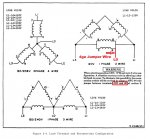- 1,159
- 1,344
- 113
- Location
- Basehor, KS
Wiring Diagram for the correct Hammond PH250MGJ as T2 replacement in A11
Ok folks,
here it is.
Math:
Original T2 Transfer Ratio:
208VAC to 128VAC = 1.625 : 1
Hammond PH250MGJ Tansfer Ratio:
387VAC to 240VAC = 1.6125 : 1
Maximum Output Current on Secondary side in this configuration: 1.04 Amps AC (twice of whats needed)
Note: a transformer does not care if you apply a lower Voltage on the primary, you will get exactly the transfer ratio on the output up to max current of the secondary - because this a CE rated transformer it is 387 instead of 380 even though it says it on the label.

And the PDF to download
Ok folks,
here it is.
Math:
Original T2 Transfer Ratio:
208VAC to 128VAC = 1.625 : 1
Hammond PH250MGJ Tansfer Ratio:
387VAC to 240VAC = 1.6125 : 1
Maximum Output Current on Secondary side in this configuration: 1.04 Amps AC (twice of whats needed)
Note: a transformer does not care if you apply a lower Voltage on the primary, you will get exactly the transfer ratio on the output up to max current of the secondary - because this a CE rated transformer it is 387 instead of 380 even though it says it on the label.

And the PDF to download
Attachments
-
226.2 KB Views: 4
Last edited:






